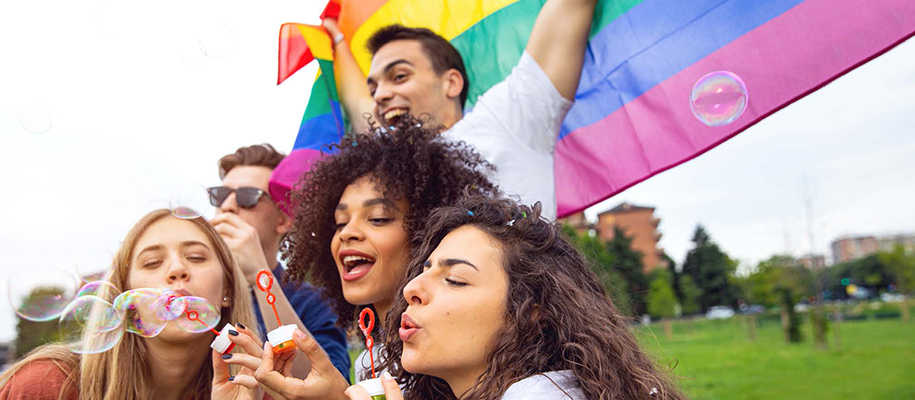June is Pride Month, a time to celebrate and honor the history, culture, and accomplishments of LGBTQ+ individuals and communities. LGBTQ+ students are more present than ever before on high school and college campuses, which requires educators to better understand the diverse needs of these students. Bullying and hates crimes against queer youth remain a prevalent problem, and many schools are challenged in trying to protect these students against continued mistreatment. Research pertaining to the campus climate for LGBTQ+ students highlights how hostile climates impact a student’s sense of belonging, safety, and mental health and wellness. Let’s take a look at how school administrators, professors, and fellow students can support LGBTQ+ students on campus—but first, a little history on Pride Month.
Where Pride Month began
Pride Month originated in New York on June 28, 1969, at the Stonewall Inn, a bar in Greenwich Village that catered to gay, lesbian, and transgender populations but was often subjected to frequent police raids, in which patrons were abused, humiliated, and discriminated against. On this night, a riot ensued between police and patrons. The resistance and defense shown by LGBTQ+ patrons demonstrated their unrelenting desire to defend their rights and be treated as equal citizens.
A year after the riots, the Gay Liberation Front organized the first Christopher Street Liberation Day Reminder March, later called the Gay Pride March. Similar marches took place across the nation, which led to the naming of June as Pride Month. Despite this social progress, it took 30 years for Pride Month to be officially recognized by the US government. President Bill Clinton declared June “Gay and Lesbian Month” in 1999, and President Barack Obama expanded this month to be more inclusive and coined it LGBTQ Pride Month in 2011.
Related: Resources and College Search Tips for LGBTQ+ Students
4 ways to support students this Pride Month
During Pride Month and beyond, it’s imperative that school personnel, educators, and even fellow students seek ways to support and empower LGBTQ+ students. Here are four strategies.
1. Learn how to create an inclusive campus culture for LGBTQ+ students
The reality for many LGBTQ+ youth is that schools are often not the safest place for them, and this can hurt their academic persistence and sense of self-confidence. In fact, 84.6% of LGBTQ+ students reported being verbally harassed, 40.1% reported being physically harassed, and 18.8% reported being physically assaulted while at school. It’s important to not only address these big issues of bullying or harassment when you witness it but to also learn how to use inclusive language to ensure campus common areas feel friendly and welcoming to LGBTQ+ students. Here are a few tips for using inclusive language:
- Avoid language that assumes the binary system of gender (men and women).
- Use other gender-inclusive alternatives that don’t assume a gender binary, like friends, students, participants, or colleagues.
- Inquire about all students’ pronouns or how they’d like to be addressed. Avoid using the term “preferred pronouns,” as it indicates that someone’s gender or sexual orientation is a matter of preference, and instead use the phrase “personal pronouns” if needed.
2. Donate to LGBTQ-focused organizations
Pride Month isn’t simply about parades and celebrations. There are many social justice organizations committed to advocating for LGBTQ+ individuals and addressing issues and challenges facing these populations, such as mental health, homelessness, and violence. With continued social and political threats, the LGBTQ+ community has faced anti-LGBTQ+ legislation, which includes local governments passing bills that attempt to silence the voices of LGBTQ+ youth and limit LGBTQ+ education in schools. It’s important to learn more about these causes and support them, especially monetarily, in any way you can. Many organizations assist with policy education, lobbying, and helping advocate for LGBTQ+ civil rights. You can start with this list of the top 10 LGBTQ+ organizations to donate to during Pride Month.
Related: 7 Scholarships That Support LGBTQ+ Students and Allies
3. Understand how intersectionality impacts student experiences
Pride Month has often been celebrated from a predominately White or Eurocentric lens, which means the experiences of LGBTQ+ youth of color are often ignored and marginalized. Intersectionality, a term coined by civil rights activist Kimberlé Crenshaw, acknowledges that social identities overlap, and people face different and intersecting forms of structural discrimination. We simply cannot view people’s experience through one singular identity—we must examine their experiences across race, class, and gender lines. LGBTQ+ youth of color are more likely to experience discrimination in housing and health care at a rate 12 percentage points higher than white LGBTQ respondents—43% compared to 31%. It's important to increase your knowledge and understanding of how different social identities impact LGBTQ+ students. GLSEN, an organization devoted to ending discrimination for LGBTQ+ youth, has produced a helpful guide on supporting LGBTQ+ youth of color to get you started.
4. Be vocal about your allyship
We live in a country where there has always been a social stigma associated with being vocal about issues pertaining to race, sexual or gender orientation, and social justice. This has led many of us to avoid talking about issues impacting the LGBTQ+ community out of fear of being told we are wrong or facing public condemnation. Historically unrepresented populations—like LGBTQ+ youth—need to know they have a community of supporters and advocates behind them. Being an ally needs to go far beyond attending a Pride Month parade and only acknowledging LGBTQ+ people during the month of June. Especially as educators, it’s important to make a lifelong commitment to understanding the adversity LGBTQ+ people face and actively working to address these injustices. Allies should attend rallies and marches as well as speak at the capital and talk to local and state representatives to demand more support for LGBTQ+ youth.
As an ally, you don’t have to get everything right. True allyship is a commitment to action and an openness to being wrong and vulnerable. Just remember, your allyship should never overshadow or diminish the voices and perspectives of LGBTQ+ youth. Don’t assume you know everything about LGBTQ+ youth—it’s important to learn from them and provide spaces and opportunities to speak authentically about their experiences.
Related: Great Colleges and Universities for LGBTQ+ Student Support
The United States is becoming even more of a melting pot, and educators, school personnel, and students alike must ensure they are competent in supporting and empowering students who often have different lived experiences and identities from their own. The profession of an educator in particular no longer requires us to treat all students the same—we must realize each student is going to require a unique level of care and concern. This Pride Month, commit to understanding the full perspectives of LGBTQ+ students while supporting them both inside and outside the classroom.
You can find even more articles and advice to support students with our “LGBTQ students” tag. Happy Pride Month!








